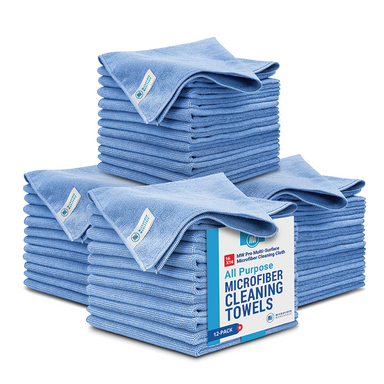2. Microfiber Quality = Cleaning Performance
Contrary to popular belief, not all microfibers are created equal.
Quality microfiber boasts high levels of fiber thinness, shred, and density, while bargain ones barely meet the minimum legal criteria to be called “microfiber.”
To be sold as microfiber, the fibers have to be 1 Decitex (dTx) or less, but good microfiber can be as thin as 0.5 dTx, which doubles the surface area for twice the dirt grabbing capacity per inch.
Legally, fibers don’t even have to be shredded, so the bargain microfiber can be completely missing the electrically charged friction that holds all the dirt and germs in place.
For example, Microfiber Wholesale manufactures some of the densest, thinnest-fiber, split-strand microfiber on the market, durably sewn for years of industrial use.
Our multi-surface towel sports over 320 GSM of split-strand microfiber, whereas most bargain towels only have 200 GSM or less.
That means with every wipe of our towel, you’ll pick up over 33% more dirt, germs, and streak-causing residue than anything else you’ve tried.
A study conducted way back in 2011 by the University of Washington revealed that microfiber fabrics with increased surface areas are able to absorb up to seven to eight times their weight in water. The same can not be said for the bargain traditional cloths that can only dream of being this efficient.
The perfect example of how this quality issue plays out is mopping.
Cheap, clunky-fibered mops fill up quickly and smear the remaining dirt, leaving streaky floors. Cleaners using bargain mops incorrectly blame their floor soaps when actually their mop left the dirt behind.
How about cotton and sponge versus microfiber? Are they more or less efficient?
In the table below, we compare the cleaning efficiency of microfiber against two traditional options: cotton towels and sponge.

















